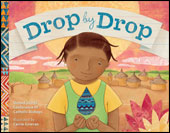
Even though I have a lot of topics to cover in preparing second graders to celebrate the Sacrament of Reconciliation and First Holy Communion, I always make it a point to introduce the corporal works of mercy to my students.
I start by reading Matthew 25:31–46, and together we list the actions listed in these Gospel verses. I then ask the children to answer the question, “What are ways you share God’s peace?” I point out how their responses are examples of at least one of the works of mercy. Thus, they learn that performing the works of mercy are ways of sharing God’s peace with others.
Next, I divide the class into small groups of three to four children and send them to different spots in our classroom where I have posted signs that list the corporal works of mercy. I then read off a good deed (such as making sandwiches to hand out to those who are homeless), and each group has to decide which work of mercy that action is. We will also play a game in which I give four examples of works of mercy, and the children go to a different corner of the room to indicate which work of mercy they would rather do. This leads to a good bit of chatter and discussion about what they choose and why—which is a good thing.
We also play a game connected to the corporal work of mercy of giving drink to the thirsty. I set up a race course and divide children into teams. Each member of the team runs a portion of the race course while carrying a one-gallon milk jug filled with water, which he or she passes off to another member of the team to run the next portion of the course. The first team to complete the entire course wins. This race has to be done outside or in a large open space (and be prepared for lots of spills). After the race we discuss how many people in the world lack clean water and how women and children in the developing world often walk miles every day to get water for their household use. We also discuss how that would prevent them from doing things we take for granted, such as playing or going to school.
Finally, we participate with the parish in preparing casseroles for a homeless shelter in Philadelphia. I took a recipe from the shelter’s website and asked families to provide one or more of the ingredients. The parish supplies the pans, and the kids get to prepare the casserole for the shelter. Thus, they are able to both feed the hungry and support an organization that gives shelter to the homeless.
How do you teach the children in your class about the works of mercy?
 Drop by Drop tells the story of Sylvie, who is unable to attend school because it takes her several hours every day to collect the water her family needs. Sylvie eventually learns that her village has been chosen for a special Water Project. Blackline Masters for Drop by Drop include lessons for grades 2–4.
Drop by Drop tells the story of Sylvie, who is unable to attend school because it takes her several hours every day to collect the water her family needs. Sylvie eventually learns that her village has been chosen for a special Water Project. Blackline Masters for Drop by Drop include lessons for grades 2–4.



Hello Im a catechists almost 20yrs and teaching religious education in a catholic school. corporal works of mercy is very helpful to teach to know them deeply the good works and greatness of our God..thank you so much my dear Sister Cindy for sharing your learnings to us and i will share it also to my students.. Godbless our mission..
Beautiful article Cindy. Thank you for sharing!